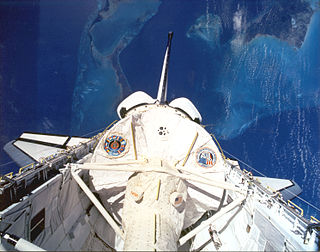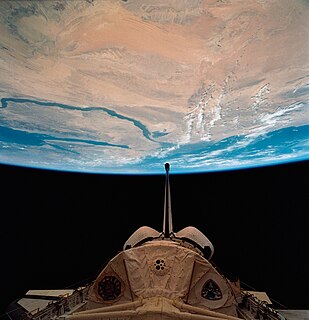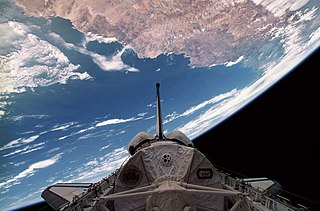
STS-31 was the 35th mission of the American Space Shuttle program, which deployed the Hubble Space Telescope into Earth orbit. The mission used the Space Shuttle Discovery, which lifted off from Launch Complex 39B on 24 April 1990 from Kennedy Space Center, Florida.

STS-50 was a United States Space Shuttle mission, the 12th mission of the Columbia orbiter. Columbia landed at Kennedy Space Center for the first time ever due to bad weather at Edwards caused by the remnants of Hurricane Darby.

STS-61-A was the 22nd mission of NASA's Space Shuttle program. It was a scientific Spacelab mission, funded and directed by West Germany – hence the non-NASA designation of D-1. STS-61-A was the ninth and last successful flight of Space Shuttle Challenger. STS-61-A holds the current record for the largest crew - eight people - aboard any single spacecraft for the entire period from launch to landing.

STS-42 was a Space Shuttle Discovery mission with the Spacelab module. Liftoff was originally scheduled for 8:45 EST 22 January 1992, but the launch was delayed due to weather constraints. Discovery successfully lifted off an hour later at 9:52 EST. The main goal of the mission was to study the effects of microgravity on a variety of organisms. The shuttle landed at 8:07 PST on 30 January 1992 on Runway 22, Edwards Air Force Base, California. STS-42 was the first of two flights in 1992 of Discovery, the second of which occurred during STS-53, which launched on 2 December 1992. The mission was also the last mission of the Space Shuttle Discovery to have a seven-member crew until STS-82, which was launched on 11 February 1997.

STS-55, or Deutschland 2 (D-2), was the 55th overall flight of the US Space Shuttle and the 14th flight of Shuttle Columbia. This flight was a multinational Spacelab flight involving 88 experiments from eleven different nations. The experiments ranged from biology sciences to simple Earth observations.

STS-57 was a Shuttle-Spacehab mission of Space ShuttleEndeavour that launched 21 June 1993 from Kennedy Space Center, Florida.

STS-58 was a mission flown by Space Shuttle Columbia launched from Kennedy Space Center, Florida, on 18 October 1993. The missions was primarily devoted to experiments concerning the physiological effects of spaceflight. This was the first in-flight use of the "Portable In-flight Landing Operations Trainer" simulation software. It was also the last time Columbia would land at Edwards Air Force Base.

William Edgar Thornton was an American NASA astronaut. He received a Bachelor of Science degree in physics from University of North Carolina and a doctorate in medicine, also from UNC. He flew on Challenger twice, the STS-8 and STS-51B missions.

STS-65 was a Space Shuttle program mission of Columbia launched from Kennedy Space Center, Florida, 8 July 1994. The commander of this flight was Robert D. Cabana who would go on later to lead the Kennedy Space Center.

STS-69 was a Space Shuttle Endeavour mission, and the second flight of the Wake Shield Facility (WSF). The mission launched from Kennedy Space Center, Florida on 7 September 1995. It was the 100th successful crewed NASA spaceflight, not including X-15 flights.

STS-73 was a Space Shuttle program mission, during October–November 1995, on board the Space Shuttle Columbia. The mission was the second mission for the United States Microgravity Laboratory. The crew, who spent 16 days in space, were broken up into 2 teams, the red team and the blue team. The mission also included several Detailed Test Objectives or DTO's.

STS-90 was a 1998 Space Shuttle mission flown by the Space Shuttle Columbia. The 16-day mission marked the last flight of the European Space Agency's Spacelab laboratory module, which had first flown on Columbia on STS-9, and was also the last daytime landing for Columbia.

Bonnie Jeanne Dunbar is an American engineer and retired NASA astronaut. She flew on five Space Shuttle missions between 1985 and 1998, including two dockings with the Mir space station. Since leaving NASA, she has worked in museums and STEM leadership, and as a professor of aerospace engineering.

A space toilet or zero gravity toilet is a toilet that can be used in a weightless environment. In the absence of weight, the collection and retention of liquid and solid waste is directed by use of airflow. Since the air used to direct the waste is returned to the cabin, it is filtered beforehand to control odour and cleanse bacteria. In older systems, wastewater is vented into space, and any solids are compressed and stored for removal upon landing. More modern systems expose solid waste to vacuum pressures to kill bacteria, which prevents odor problems and kills pathogens.

The Neutral Buoyancy Simulator was a neutral buoyancy pool located at NASA's George C. Marshall Space Flight Center (MSFC). Engineers and astronauts developed hardware and practiced procedures in this tank from its completion in 1968 through its decommissioning in 1997. Marshall recognized the need for underwater simulations of extra-vehicular activities (EVAs) and developed three successively larger tanks for the purpose. The Neutral Buoyancy Simulator contributed significantly to the American crewed space program. Skylab, the Space Shuttle, Hubble Space Telescope, and the International Space Station have all benefited from the Neutral Buoyancy Simulator. Until Johnson Space Center constructed the Weightless Environment Test Facility in the mid-1970s, MSFC had the only NASA-owned test facility that allowed engineers and astronauts to become familiar with the dynamics of body motion under weightless conditions.

The Extended Duration Orbiter (EDO) program was a project by NASA to prepare for long-term (months) microgravity research aboard Space Station Freedom, which later evolved into the International Space Station. Scientists and NASA needed practical experience in managing progressively longer times for their experiments. The original Space Shuttle configuration usually provided a week to ten days of spaceflight. Several research projects and hardware components were part of the project, of which the EDO-pallet was one of the most visible, contracted by Rockwell International.

The Constellation Space Suit was a planned full pressure suit system that would have served as an intra-vehicular activity (IVA) and extra-vehicular activity (EVA) garment for the proposed Project Constellation flights, which were planned to begin after the Space Shuttle retired. The design of the suit was announced by NASA on June 11, 2008, and it was to be manufactured by Houston, Texas-based Oceaneering International, the first company other than the David Clark Company, Hamilton Sundstrand, and ILC Dover to produce life-support hardware, as a prime contractor, for in-flight space use.

The Treadmill with Vibration Isolation Stabilization System, commonly abbreviated as TVIS, is a treadmill for use on board the International Space Station and is designed to allow astronauts to run without vibrating delicate microgravity science experiments in adjacent labs. International Space Station treadmills, not necessarily described here, have included the original treadmill, the original TVIS, the БД-2, the Combined Operational Load-Bearing External Resistance Treadmill (COLBERT), and the Treadmill 2. Some share a name, some a design, some a function, some use different (passive) vibration-suppression systems, some it is unclear how they differ.
Neutral buoyancy simulation with astronauts immersed in a neutral buoyancy pool, in pressure suits, can help to prepare astronauts for the difficult task of working while outside a spacecraft in an apparently weightless environment.
Skeletal muscles, particularly postural muscles of the lower limb, undergo atrophy and structural and metabolic alterations during space flight. The relationships between in-flight exercise, muscle changes and performance are not well understood. Efforts should be made to try to understand the current status of in-flight and post-flight exercise performance capacity and what the goals/target areas for protection are with the current in flight exercise program.



















